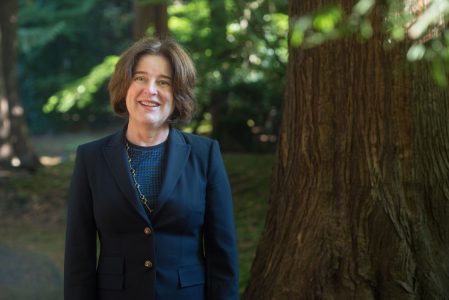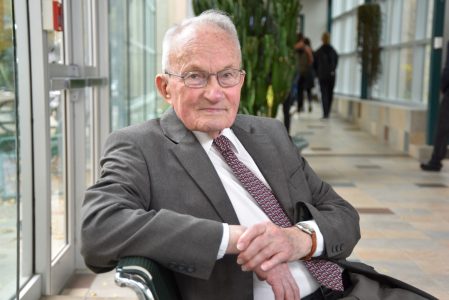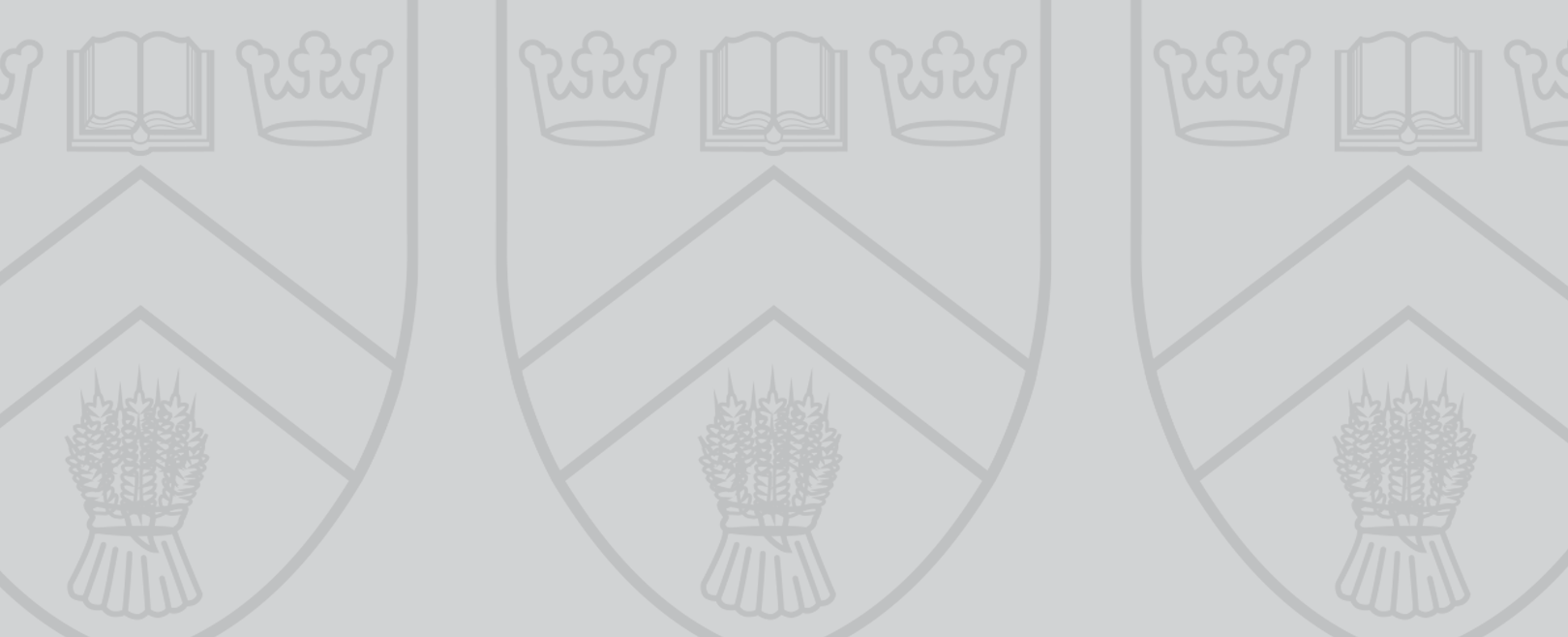
A world-class medical microbiologist and infectious disease expert, and a dedicated educator and respected history professor are this fall’s honorary degree recipients.
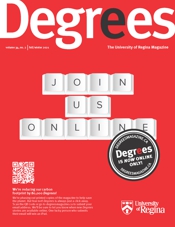

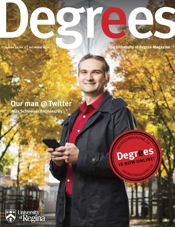

A world-class medical microbiologist and infectious disease expert, and a dedicated educator and respected history professor are this fall’s honorary degree recipients.

Indigenous Languages, Arts and Cultures professor Andrew Miller was poking around the basement of First Nations University of Canada when he came across almost 600 photos, most of them depicting late 19th century and early 20th century Indigenous life.
Read More

When she graduated from the University of Regina’s School of Journalism in 2002, Michelle Brass had the world by the tail. She was landing her dream jobs, including one at CBC Radio as the host of The Afternoon Edition. Then, just as her young career was skyrocketing, she gave it all up in search of a truer existence rooted in her Saulteaux heritage.
Read More
It was the start of a new school year in September 2016 when Andrew Miller inadvertently stumbled across a binder of 587 black and white photos in the basement collection of First Nations University of Canada’s Library (Special Collections). The photos, taken between 1877 and 1949, portray the lives of Indigenous peoples on the Canadian Plains. Nobody knew where the photos came from or how they became part of the collections. What was clear is that the photos had been archived, most likely by the Provincial Archives of Saskatchewan (formerly known as the Saskatchewan Archives Board).
Miller views sharing the photos with Indigenous communities not only as a way to deconstruct the colonial narrative but also as a repatriating practice.
Not all of the photographs have captions, but Miller is troubled by many of those that do. Referring to the collection as “colonial photography,” Miller has real concerns that the limited descriptions provided epitomize a settler narrative.
“Some of these photos and their descriptions really fit the colonial gaze,” he says. “I’m not overly concerned with factual names and events. I just feel as though the Indigenous community needs to see these first-hand.”
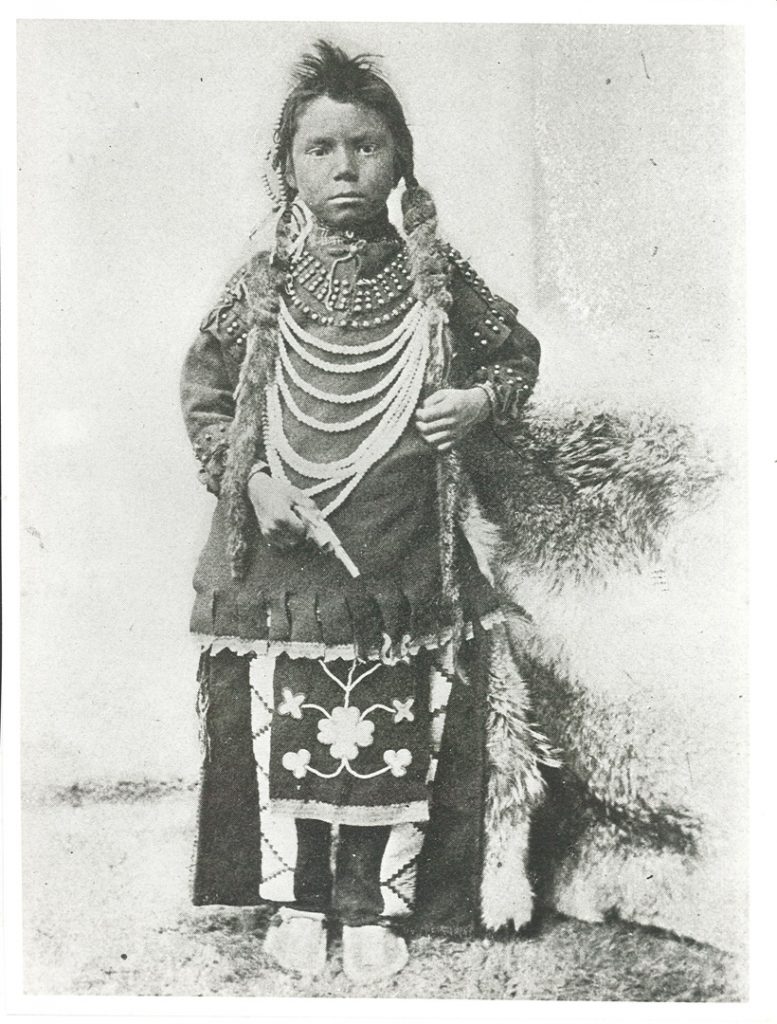 Thomas Moore circa 1897. (Photo courtesy of First Nations University of Canada
Thomas Moore circa 1897. (Photo courtesy of First Nations University of Canada
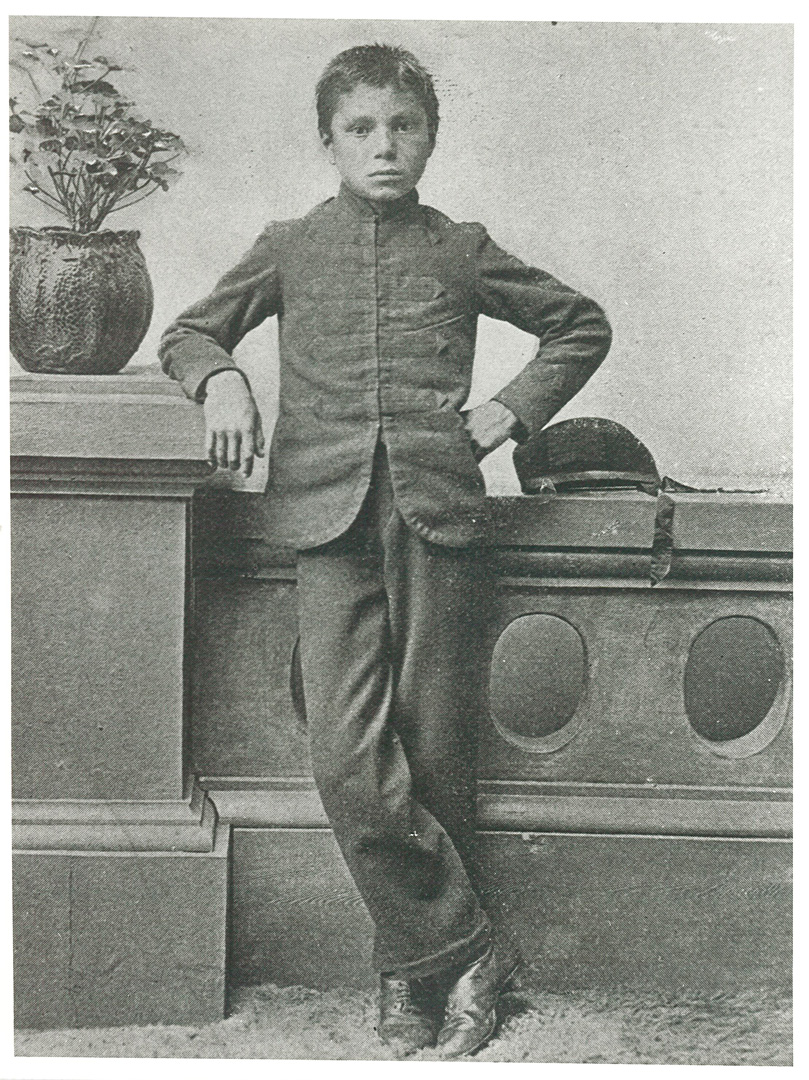 Thomas Moore after entrance in Regina Industrial School circa 1897. (Photo courtesy of First Nations University of Canada)
Thomas Moore after entrance in Regina Industrial School circa 1897. (Photo courtesy of First Nations University of Canada)
Miller views sharing the photos with Indigenous communities not only as a way to deconstruct the colonial narrative but also as a repatriating practice. He knew his first step was to consult Elders to ensure that the photo sharing was handled in the most culturally appropriate way. He received advice on protocols; what could be shared and what shouldn’t be public knowledge. Elders recommended that the photos be brought out in a ceremonial manner because telling stories of ancestors had to be done in a way that expressed gratitude.
“The simple process of bringing photos to the world and saying, ‘Here, let’s talk about these,’ is not doing things in the proper way,” Miller acknowledges.
To fully realize his hopes of humanizing the photographs and contextualizing the collection, Miller needed to expose the photos to a larger audience. In fall 2017, he took a sample of the photographs to Treaty 4 Days at Fort Qu’Appelle.
Miller’s display was set up amongst other organizations’ booths and local artisan kiosks. Samplings of photos were placed around the room, particularly those that had been taken in Treaty 4 Territory. Miller says the response that day was good. From the 30 photos displayed, at least half ignited conversations, comments and recognition from those who viewed them. One of those conversations was started by Wayne Goodwill.
“Wayne immediately was fixated on the photo of Martha Taweyaka and her husband Louis,” Miller says.
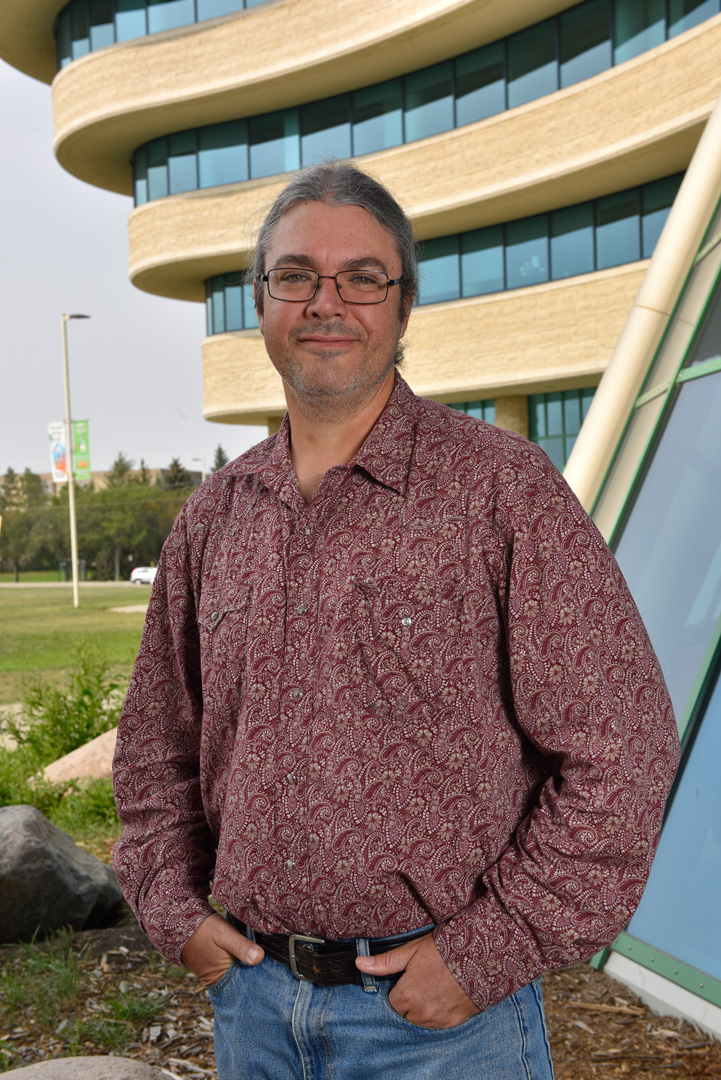 First Nations University of Canada Indigenous Languages, Arts and Cultures professor Andrew Miller. (Photo by Rae Graham)
First Nations University of Canada Indigenous Languages, Arts and Cultures professor Andrew Miller. (Photo by Rae Graham)
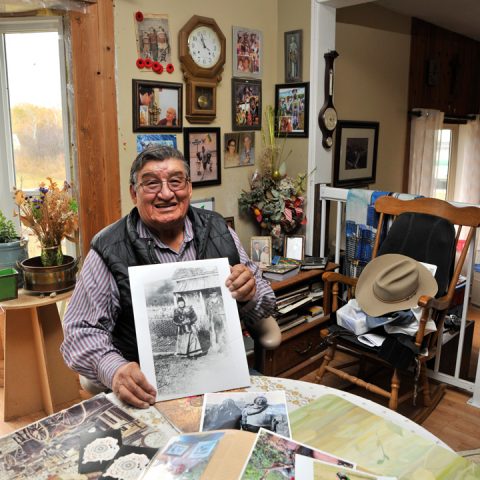 Wayne Goodwill is photographed with the photo he saw at Treaty 4 Days in Fort Qu’Appelle, Saskatchewan. Goodwill recognized the woman in the photo as his grandmother, Martha Taweyaka and her husband Louis Taweyaka. (Photo by Don Hall)
Wayne Goodwill is photographed with the photo he saw at Treaty 4 Days in Fort Qu’Appelle, Saskatchewan. Goodwill recognized the woman in the photo as his grandmother, Martha Taweyaka and her husband Louis Taweyaka. (Photo by Don Hall)
It was the first time Goodwill had seen the photo, but he knew the woman — it was his great-grandmother.
Goodwill is from Standing Buffalo First Nation and is a well-respected Knowledge Keeper in his community. An avid hunter and a long-time artist, Goodwill attended the Qu'Appelle Indian Residential School in Lebret. Many years ago, Goodwill’s aunt shared with him a story of his great-grandmother Martha at the last Sundance (or Ghost Dance) that Sitting Bull attended in the Canadian territory. The ceremony would have been around 1880 when Taweyaka was still a young girl.
Taweyaka loved her community and was known to partake in the community’s Powwows. Her husband Louis was an announcer — or as they were known at the time, one of “the criers.” Goodwill suggests she would have danced in outfits similar to the one she is wearing in the photograph.
“She was a teacher who helped open the day school on Standing Buffalo reserve,” Goodwill explains. “She even cut the ribbon on its opening day.” Goodwill has come to know that Taweyaka was well-respected and fluent in English. She travelled to the Standing Buffalo area after her marriage to Louis. Although it is still unclear as to where she resided before settling there, Goodwill is certain Taweyaka is of Lakota and Dakota ancestry. The couple had four children.
Miller suggests that sharing the photos is the only way to bring the subjects to life. “Martha went from being anonymous to being a person who has a fully developed story,” he says.
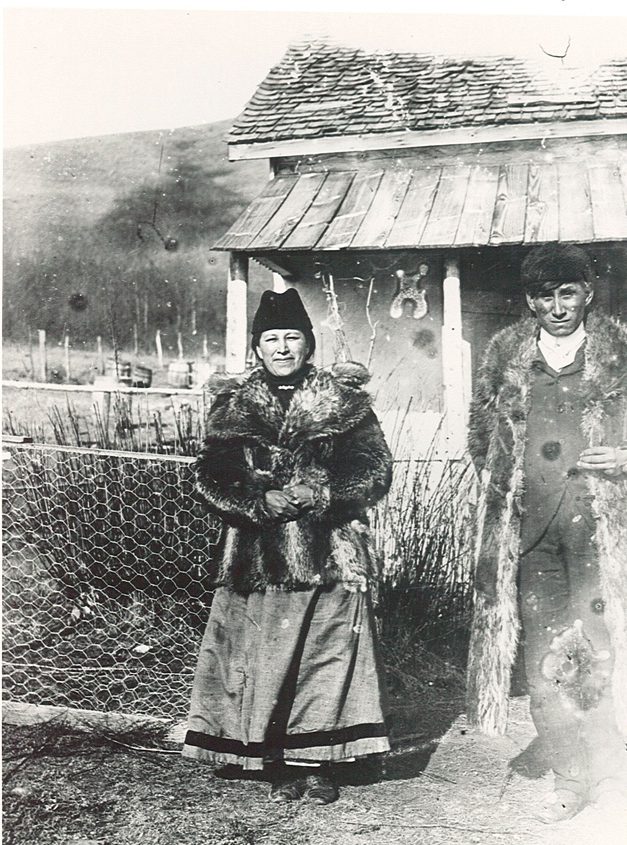 Photo from the First Nations University of Canada archive of Louis and Martha Taweyaka in front of A. Rooke's house near Fort Qu'Appelle. The couple were married in 1897. (Photo courtesy of First Nations University of Canada)
Photo from the First Nations University of Canada archive of Louis and Martha Taweyaka in front of A. Rooke's house near Fort Qu'Appelle. The couple were married in 1897. (Photo courtesy of First Nations University of Canada)
Miller notes that the residential schools tried to erase familial lines. “It’s time to flip that narrative and challenge it. It is important to keep in mind who is on the other side of the photographs,” he adds.
It had always been Miller’s hope that an Indigenous archivist would take over the project and connect it to Indigenous communities in a way that he never could. A year after the photographs were displayed at Treaty 4 Days, Miller was approached by a master’s student in archival studies from the University of Manitoba. Carmen Miedema, originally from the Peepeekisis Cree Nation in Saskatchewan and an archivist for the National Centre for Truth and Reconciliation, has a keen interest in the collection.
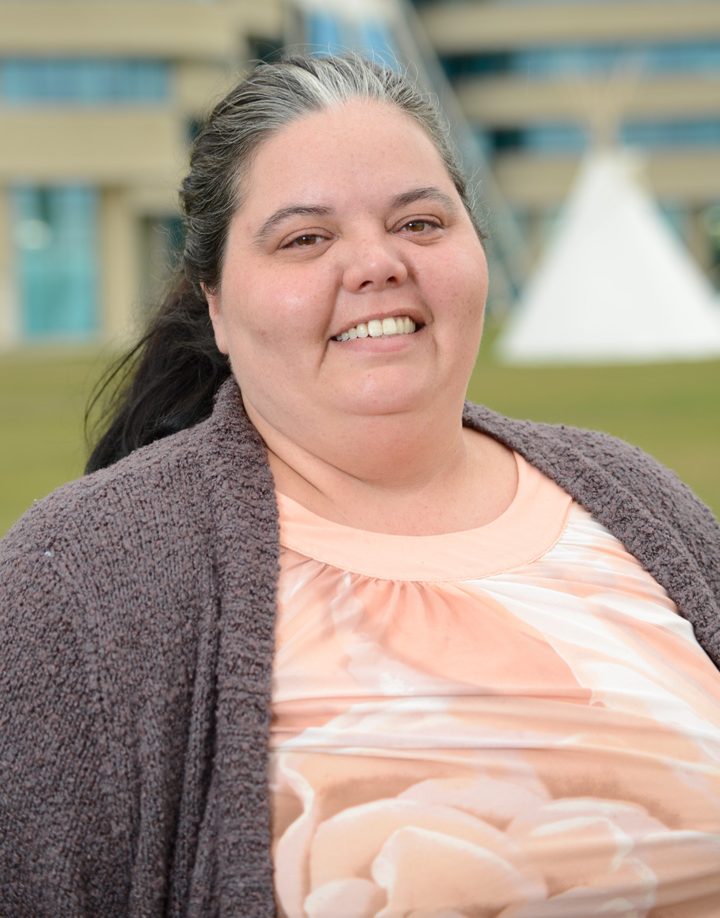 Carmen Miedema, a master’s student in archival studies at the University of Manitoba has a keen interest in the FNUC archive photo collection. Miedema is also an archivist for the National Centre for Truth and Reconciliation. (Photo by Trevor Hopkin)
Carmen Miedema, a master’s student in archival studies at the University of Manitoba has a keen interest in the FNUC archive photo collection. Miedema is also an archivist for the National Centre for Truth and Reconciliation. (Photo by Trevor Hopkin)
“I became interested in the collection while completing an assignment during my undergraduate degree at Brandon University,” Miedema says. “It was also during this time that I learned that archival practices are still extraordinarily colonial and unfair to Aboriginal peoples — something I’d like to change.”
Miedema has plans to take the photographs and tour them throughout Manitoba. It is her hope that the photographs will be more appropriately recognized in an Indigenous context and, more importantly, will be repatriated to the communities in which the photographs were taken.
“Telling our own histories is crucial to being able to teach future generations about our truths, in our languages and through our protocols.”
Miedema believes it is essential to archive Indigenous stories in an Indigenous context. “We should have the right to tell our stories the way we see, experience and understand them,” she says. “It is important because how we look at, experience and understand our stories is often completely different than the colonial point of view in which they have been written. Telling our own histories is crucial to being able to teach future generations about our truths, in our languages and through our protocols. It means giving power back to our people.”
Miller often gets people reaching out to him who have family ties to a photograph. He hopes that will continue on an even larger scale once the photos become more accessible through an online database. The online project is funded, in part, by a generous donation from Pasqua First Nation’s Chief Todd Pagan, who is enthusiastic to see Indigenous students working on the database.
Cheepoostatin, also known as Pointed Cap, a respected Elder of the Indian File Hills Agency, receiving treaty money in 1916. Cheepoostatin was 108 years old when the photo was taken.
(Photo courtesy of First Nations University of Canada)
“There are a number of photos that specifically relate to Chief Pagan’s community,” Miller explains. “The database would allow the people of Pasqua First Nation and area to easily access the photos and share them within their community. Students, researchers and community members will be able to access them. They have been in the provincial archives but they’re not scanned or online or easily accessible. You’d have to be there in person or ask for the photo by name, which is too tall of an obstacle.”
Once the project is complete, Miller says all the photographs from the collection will be available through the First Nations University of Canada website. Then, students like Miedema, community members like Goodwill, or anyone else with an interest will be able to access these important, historical photographs in their proper context.
[post_title] => The big picture [post_excerpt] => Indigenous Languages, Arts and Cultures professor Andrew Miller was poking around the basement of First Nations University of Canada when he came across almost 600 photos, most of them depicting late 19th century and early 20th century Indigenous life. [post_status] => publish [comment_status] => open [ping_status] => open [post_password] => [post_name] => the-big-picture [to_ping] => [pinged] => [post_modified] => 2018-11-16 11:10:05 [post_modified_gmt] => 2018-11-16 17:10:05 [post_content_filtered] => [post_parent] => 0 [guid] => https://www.degreesmagazine.ca/?p=2114 [menu_order] => 0 [post_type] => post [post_mime_type] => [comment_count] => 0 [filter] => raw ) WP_Post Object ( [ID] => 2115 [post_author] => 12 [post_date] => 2018-11-02 08:56:41 [post_date_gmt] => 2018-11-02 14:56:41 [post_content] => I ’ve always been driven by a strong sense of purpose. I vividly recall a moment from my childhood. I’m seven years old, staring at the side of my hand where my brown skin meets the lighter, paler skin of my palm. As I stare at the line where brown meets white, I am struck with a deep knowing, an understanding that I am both Indigenous and non-Indigenous, and that this is somehow significant. It’s one of my most powerful memories. It has defined the trajectory of my life."This deep longing to remember who I am is my spirit calling to me. It’s the spark, a fire lit within. Sometimes the blaze is strong and bright. Other times it’s an ember, a tiny point of light in the vast darkness. It never goes out."Growing up, I struggled with my identity. My ancestry is mixed: Saulteaux on my mom’s side and English/Swiss on my dad’s side. Although I had deeper relationships with my extended family on my dad’s side, I have always felt a much stronger connection to my Saulteaux heritage. Journalism school graduate Michelle Brass at her home on the Peepeekisis Cree Nation. (Photo by Don Hall) I didn’t grow up with my culture or language. More than one hundred years of racist government policies aimed at assimilation made sure of that. During the residential school era, they tried to “kill the Indian in the child.” But they couldn’t, despite Canada’s best efforts. They could dim the flame, but could not extinguish the spark. That spark is our spirit. It is our blood memory. It is strong and it will always call us home.
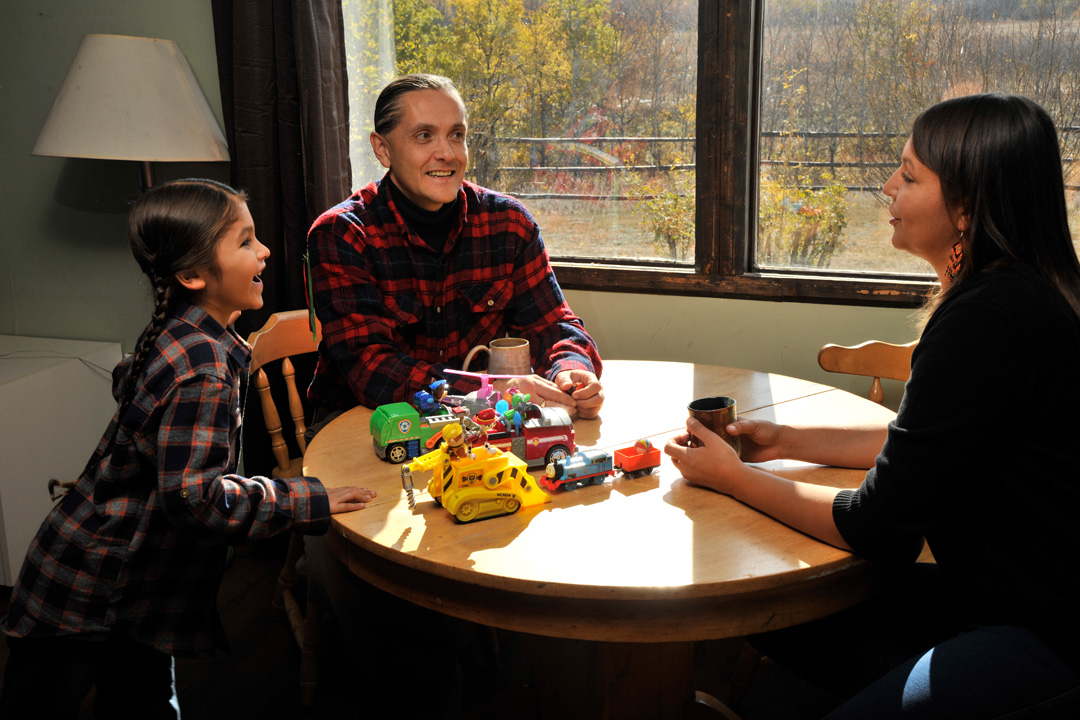 Brass enjoys some quality time with husband Phillip Brass and son, Forest in their Peepeekisis home. (Photo by Don Hall)
I’ve spent my life hearing that call. This deep longing to remember who I am is my spirit calling to me. It’s the spark, a fire lit within. Sometimes the blaze is strong and bright. Other times it’s an ember, a tiny point of light in the vast darkness. It never goes out. It’s the driving force behind everything I do. It guides me along a particular life path that’s been both a blessing and a burden.
I experience the deep fulfillment and joy of reconnecting to Indigenous ceremonies and teachings. I also engage with emotionally exhausting work that’s created the most anguish in my life; searching for a way to reconcile two completely different cultures inhabiting the same space, both figuratively and literally. My inner world and the outer world reflect the same struggle – Indigenous and non-Indigenous worldviews attempting, but failing, to live harmoniously. This dichotomy, and searching for a way to reconcile the two, has essentially become my life’s work, for better or for worse.
Brass enjoys some quality time with husband Phillip Brass and son, Forest in their Peepeekisis home. (Photo by Don Hall)
I’ve spent my life hearing that call. This deep longing to remember who I am is my spirit calling to me. It’s the spark, a fire lit within. Sometimes the blaze is strong and bright. Other times it’s an ember, a tiny point of light in the vast darkness. It never goes out. It’s the driving force behind everything I do. It guides me along a particular life path that’s been both a blessing and a burden.
I experience the deep fulfillment and joy of reconnecting to Indigenous ceremonies and teachings. I also engage with emotionally exhausting work that’s created the most anguish in my life; searching for a way to reconcile two completely different cultures inhabiting the same space, both figuratively and literally. My inner world and the outer world reflect the same struggle – Indigenous and non-Indigenous worldviews attempting, but failing, to live harmoniously. This dichotomy, and searching for a way to reconcile the two, has essentially become my life’s work, for better or for worse.
"I didn’t realize it at the time, but the pain I was experiencing was a very deep, profound grief over everything that has been taken from our people. I was grieving for something I never had the chance to have. But my spirit remembered and was crying out for me to recall, reconnect and reclaim our traditional ways of living."This calling is what drove me to pursue a journalism career at 17. I believed if Canadians understood our shared history and Indigenous perspectives, we could create a stronger future. I had grand notions of building bridges between Indigenous and non-Indigenous people and healing this damaged relationship through storytelling. My passion and purpose, my fire, propelled me forward. I completed the Indian Communication Arts program at the Saskatchewan Indian Federated College and graduated with distinction from the School of Journalism in 2002. I landed the internships of my choice and won competitive scholarships, including two major student awards from the Radio and Television News Directors Association. They are among the top national awards in the industry. I was offered jobs immediately upon graduation. The spark within me was ablaze. I was young, idealistic and ambitious.
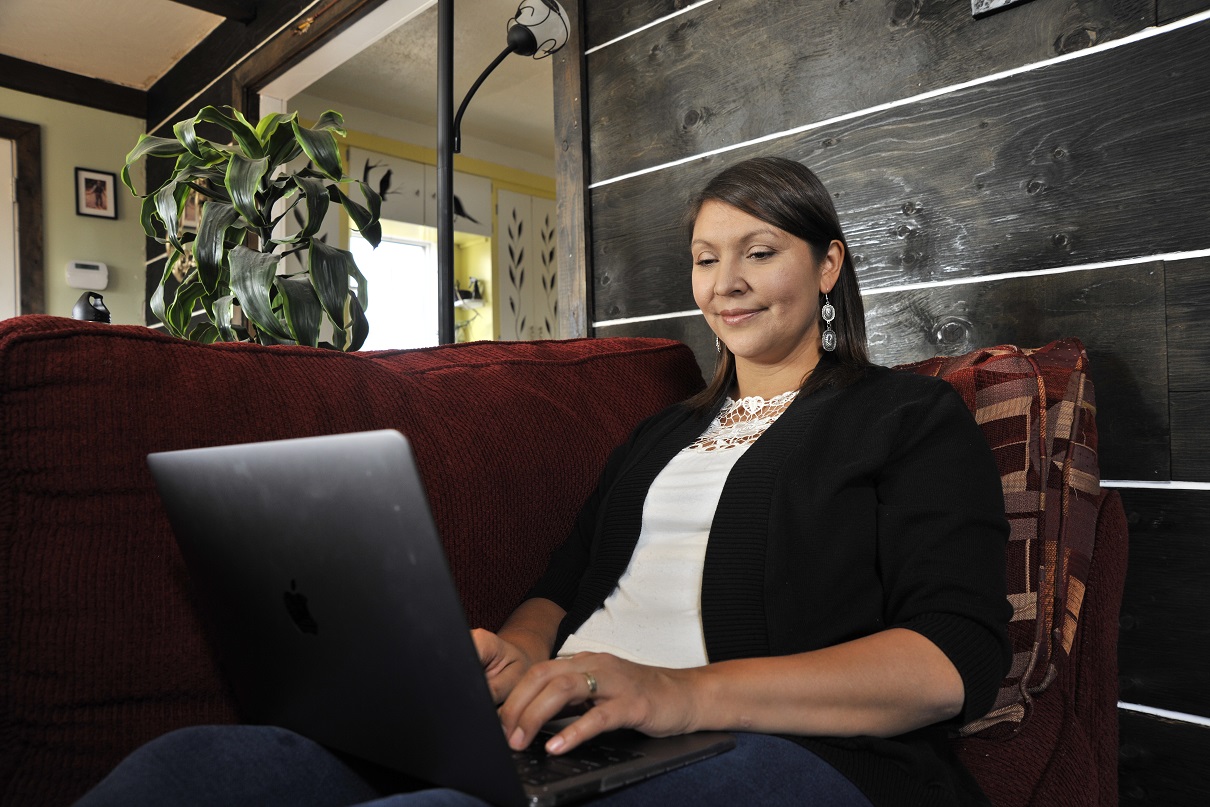 Brass works on her writing at her home on Peepeekisis Cree Nation. (Photo by Don Hall)
Over the next decade, I built my career and landed my dream jobs. I was a TV and radio reporter for CBC Saskatchewan. I did corporate communications for the City of Regina and the Federation of Sovereign Indigenous Nations. I was recruited as editor of Shout, a glossy, monthly magazine for Indigenous youth across the province. I landed my own provincial talk show on CJME NewsTalk Radio. I wrote a monthly column for the Saskatoon StarPhoenix and Regina Leader-Post. I was host of The Afternoon Edition on CBC Radio in Saskatchewan. All of my dreams had come true.
Except they really hadn’t.
Behind my career success, I experienced incredible emotional and spiritual pain due to unresolved intergenerational trauma. The weight of my anguish was crushing me and nothing seemed to help. Deep down, I knew my healing would come from my culture and ceremony. I yearned and searched for my cultural teachings. I learned bits and pieces here and there but, without family connections to my culture, I hit a lot of dead ends.
I didn’t realize it at the time, but the pain I was experiencing was a very deep, profound grief over everything that has been taken from our people. I was grieving for something I never had the chance to have. But my spirit remembered and was crying out for me to recall, reconnect and reclaim our traditional ways of living.
Brass works on her writing at her home on Peepeekisis Cree Nation. (Photo by Don Hall)
Over the next decade, I built my career and landed my dream jobs. I was a TV and radio reporter for CBC Saskatchewan. I did corporate communications for the City of Regina and the Federation of Sovereign Indigenous Nations. I was recruited as editor of Shout, a glossy, monthly magazine for Indigenous youth across the province. I landed my own provincial talk show on CJME NewsTalk Radio. I wrote a monthly column for the Saskatoon StarPhoenix and Regina Leader-Post. I was host of The Afternoon Edition on CBC Radio in Saskatchewan. All of my dreams had come true.
Except they really hadn’t.
Behind my career success, I experienced incredible emotional and spiritual pain due to unresolved intergenerational trauma. The weight of my anguish was crushing me and nothing seemed to help. Deep down, I knew my healing would come from my culture and ceremony. I yearned and searched for my cultural teachings. I learned bits and pieces here and there but, without family connections to my culture, I hit a lot of dead ends.
I didn’t realize it at the time, but the pain I was experiencing was a very deep, profound grief over everything that has been taken from our people. I was grieving for something I never had the chance to have. But my spirit remembered and was crying out for me to recall, reconnect and reclaim our traditional ways of living.
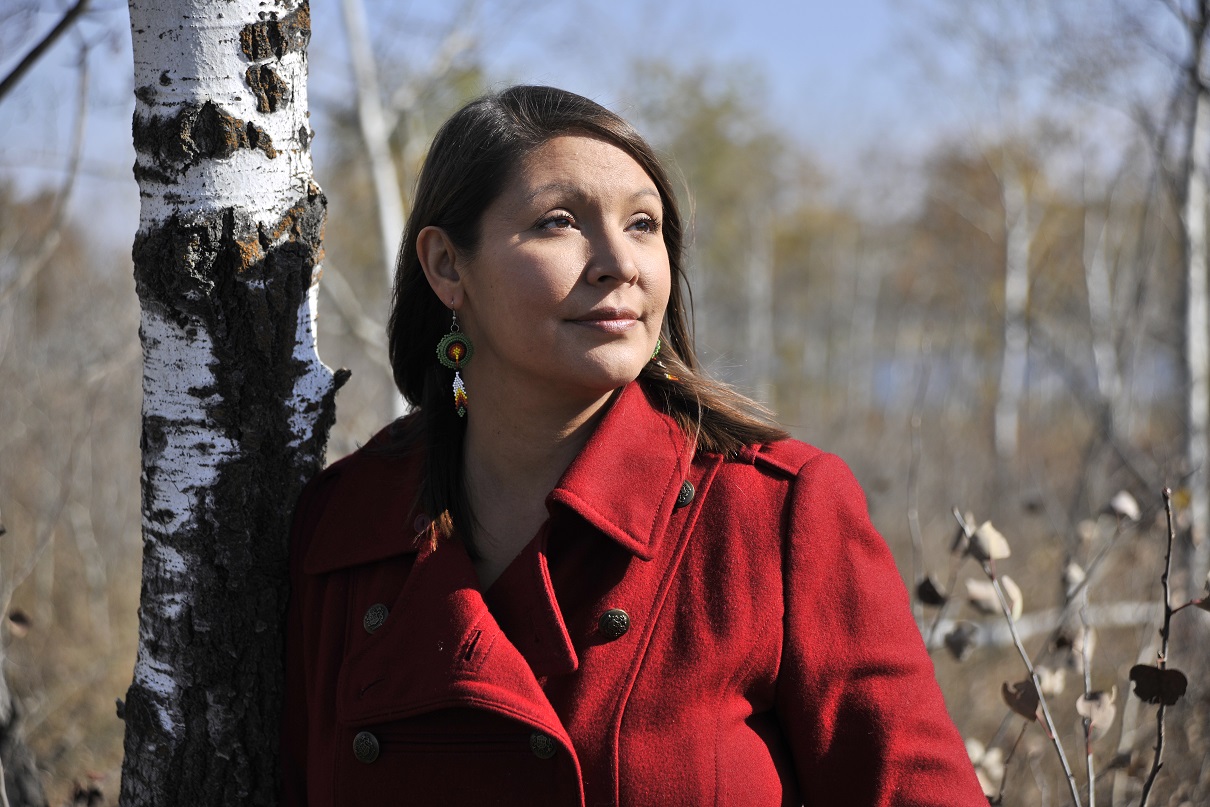 Brass was a rising star in the journalism field until she turned her back on her chosen career to focus on Indigenous food sovereignty, climate change, Indigenous health and wellness and personal healing and transformation. (Photo by Don Hall)
Some people say we lost our culture, language and way of life. My journalism career taught me the importance of language and word selection. We didn’t lose our culture as though we were careless. That’s like saying we lost our keys. Our entire way of life — everything — was maliciously stolen from us. It’s important to say that, to tell the truth. If the idea of reconciliation is to be a real possibility (and I’m not at all convinced that it is, at least not in my lifetime), we must start by telling the truth of what happened and continues to happen on these lands.
This desire to tell the truth and begin healing this relationship is what inspired me to pursue journalism over other professions. Throughout my career, I maintained a deep commitment to covering Indigenous stories in a fair and accurate manner and to covering all stories with integrity and excellence. I’d like to think I made a difference through my news stories, interviews and writing. I poured my heart and soul into this work to help build a stronger future for all of us.
Brass was a rising star in the journalism field until she turned her back on her chosen career to focus on Indigenous food sovereignty, climate change, Indigenous health and wellness and personal healing and transformation. (Photo by Don Hall)
Some people say we lost our culture, language and way of life. My journalism career taught me the importance of language and word selection. We didn’t lose our culture as though we were careless. That’s like saying we lost our keys. Our entire way of life — everything — was maliciously stolen from us. It’s important to say that, to tell the truth. If the idea of reconciliation is to be a real possibility (and I’m not at all convinced that it is, at least not in my lifetime), we must start by telling the truth of what happened and continues to happen on these lands.
This desire to tell the truth and begin healing this relationship is what inspired me to pursue journalism over other professions. Throughout my career, I maintained a deep commitment to covering Indigenous stories in a fair and accurate manner and to covering all stories with integrity and excellence. I’d like to think I made a difference through my news stories, interviews and writing. I poured my heart and soul into this work to help build a stronger future for all of us.
"So just like that, I quit my career. My passion and purpose were gone. Without it, the work felt hollow and meaningless."But one day, out of the blue, it all felt like a total waste of my time and energy. I was spending my life inside a newsroom feeding a never-ending news cycle instead of doing the real work of picking up the pieces of our culture that our parents, grandparents and great-grandparents left behind. Suddenly everything felt futile and silly. I couldn’t stand the newsroom, the on-air banter and five-minute interviews. Even more, I couldn’t stand having to continually educate my colleagues about Indigenous-Canadian facts and history, battling ridiculous stereotypes and reading racist comments on online news stories. I was completely done with it all. So just like that, I quit my career. My passion and purpose were gone. Without it, the work felt hollow and meaningless. Not only was I done with journalism, I wanted nothing to do with building bridges between Indigenous and non-Indigenous people. I was done with that too. My flame had been snuffed out. It’s taken me eight years to realize the fire is still there. An ember, burning steadily, guiding me and steering me in ways I didn’t understand or welcome at the time. After leaving journalism, my husband and I moved to Peepeekisis Cree Nation. In the first year we spent a lot of time with wonderful Cree knowledge keepers attending ceremonies, picking medicines and learning teachings. Our son was born and we continued down this path, going to the lodges and learning and living by the teachings as best we could. We’re deeply committed to this way of life. Ceremonies and teachings set the foundation for everything we do.
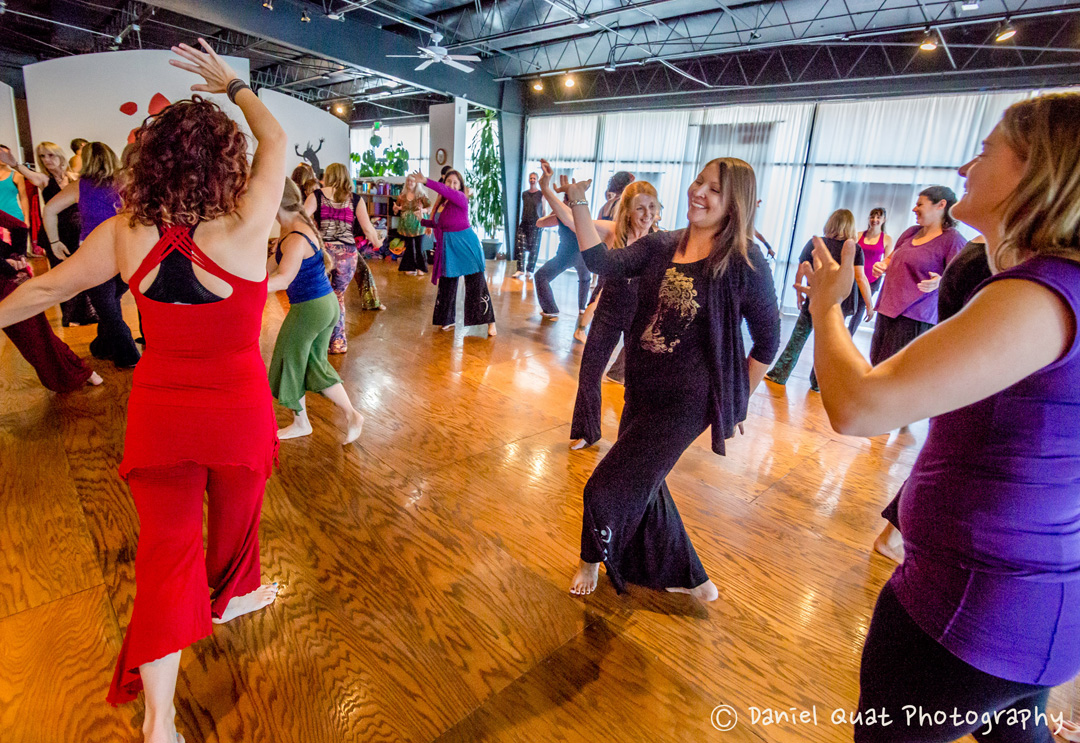 Brass (centre in purple) facilitates a session of JourneyDance, a therapeutic dance form that uses music, freestyle movement and imagery to release emotions and create healing. (Photo courtesy of Michelle Brass)
I also searched for a new career. I became an integrative nutrition health coach and took on some clients. I discovered JourneyDance, a therapeutic dance form that uses music, freestyle movement and imagery to release emotions and create healing in our lives. I completed three modules of intensive training to become a JourneyDance certified facilitator and began to lead classes and workshops. I also studied at the Martha Beck Institute for a year to become a life coach. These modalities, combined with Indigenous ceremonies as my foundation, started me on a path of deep healing. I wanted to share these tools with others on a similar path. Everything in my life was centred around holistic health, healing and living in a place of freedom and joy. I was excited to lead workshops and coaching programs to help people live lives full of purpose and meaning.
Brass (centre in purple) facilitates a session of JourneyDance, a therapeutic dance form that uses music, freestyle movement and imagery to release emotions and create healing. (Photo courtesy of Michelle Brass)
I also searched for a new career. I became an integrative nutrition health coach and took on some clients. I discovered JourneyDance, a therapeutic dance form that uses music, freestyle movement and imagery to release emotions and create healing in our lives. I completed three modules of intensive training to become a JourneyDance certified facilitator and began to lead classes and workshops. I also studied at the Martha Beck Institute for a year to become a life coach. These modalities, combined with Indigenous ceremonies as my foundation, started me on a path of deep healing. I wanted to share these tools with others on a similar path. Everything in my life was centred around holistic health, healing and living in a place of freedom and joy. I was excited to lead workshops and coaching programs to help people live lives full of purpose and meaning.
"It stoked the fire within and now it blazes red hot. My passion and purpose have returned. I stand, with my ancestors behind me, for the water, air, soil, animals, plants and our future with a fierce love and determination."It was a wonderful period of transition, discovery and healing. Throughout this time, however, I couldn’t shake a sense of duty and responsibility to bring Indigenous and non-Indigenous people together. I tried repeatedly to let it go, but the idea wouldn’t let go of me. I didn’t want to work in the intersections of Indigenous and non-Indigenous anymore. But my lineage includes both the colonized and the colonizers, and so it seems the work I came here to do sits firmly within that realm. It has become painfully clear to me that I can quit my career but I can’t quit my calling. The spark that drove me to succeed is still there, guiding me forward. It’s my ancestors calling me to do my part. As an Indigenous woman, I have a responsibility to my community, particularly to our children. We receive guidance in our lodges. We all have work to do. For me, that is accepting and honouring my identity and heritage by working with both Indigenous and non-Indigenous peoples to work out how we will share this space in a way that provides a good life for all.
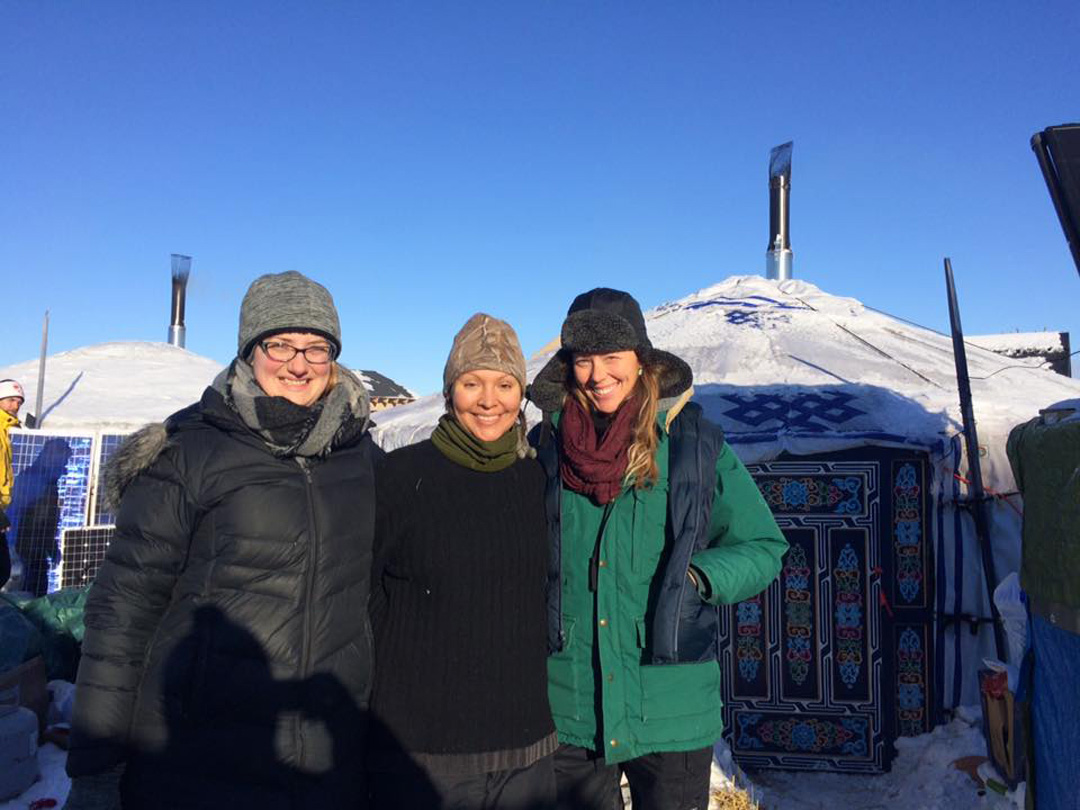 Brass with friends at Standing Rock Indian Reservation, site of the Dakota Access Pipeline protest. (Photo courtesy of Michelle Brass)
In December 2016, I went to Standing Rock for ten days to support our Lakota brothers and sisters protecting the water. I spent my time with the Indigenous midwives in the medic camp. We shared stories, songs and teachings with one another about the role of our women as we protect Mother Earth and live according to her natural laws. To say the experience was profound feels trite. It created a deep shift in me and brought everything in my life into sharp focus.
I left there with a renewed commitment to work for the Creator, to heed the guidance of the Grandmothers and Grandfathers (our spirit guides), to be in service to Mother Earth, women and future generations. It stoked the fire within and now it blazes red hot. My passion and purpose have returned. I stand, with my ancestors behind me, for the water, air, soil, animals, plants and our future with a fierce love and determination.
Brass with friends at Standing Rock Indian Reservation, site of the Dakota Access Pipeline protest. (Photo courtesy of Michelle Brass)
In December 2016, I went to Standing Rock for ten days to support our Lakota brothers and sisters protecting the water. I spent my time with the Indigenous midwives in the medic camp. We shared stories, songs and teachings with one another about the role of our women as we protect Mother Earth and live according to her natural laws. To say the experience was profound feels trite. It created a deep shift in me and brought everything in my life into sharp focus.
I left there with a renewed commitment to work for the Creator, to heed the guidance of the Grandmothers and Grandfathers (our spirit guides), to be in service to Mother Earth, women and future generations. It stoked the fire within and now it blazes red hot. My passion and purpose have returned. I stand, with my ancestors behind me, for the water, air, soil, animals, plants and our future with a fierce love and determination.
"My work is about developing my relationship with the land and understanding and respecting our natural laws. It’s about learning our languages, ceremonies, teachings and way of life. This is what will heal us. This is what will save us."I’ve resisted for a very long time but I’ve finally found my way back to wanting to heal the relationship between Indigenous and non-Indigenous peoples. It’s different now. It’s evolved. Before, I focused on healing the past. Now, it’s about standing up for our future. We’ve been warned in our ceremonies about hard times coming. Climate change poses the greatest threat we’ve ever faced and will require extreme changes on a massive scale. We must work together. Traditional Indigenous knowledge is vital for the survival of our children and grandchildren. It always has been. I no longer have any interest in trying to change colonial systems to improve the lives of Indigenous people. Instead, my focus is on strengthening our traditional knowledge systems and adhering to our ancient teachings. My work is about developing my relationship with the land and understanding and respecting our natural laws. It’s about learning our languages, ceremonies, teachings and way of life. This is what will heal us. This is what will save us. For years, I’ve tried to walk in two worlds; to discover who I am and connect to my roots, while simultaneously achieving success in my career and western society. But I’ve come to realize we’re not meant to walk in two worlds. We’re meant to walk in one world. The real world. The world of grass and soil and land, the world of water and air and trees and plants. The world of the four-legged and the winged and water creatures. The world of relationships and kinship. The real, natural world where Mother Earth is calling for all of us to remember who we are and how to live with her and with one another.

